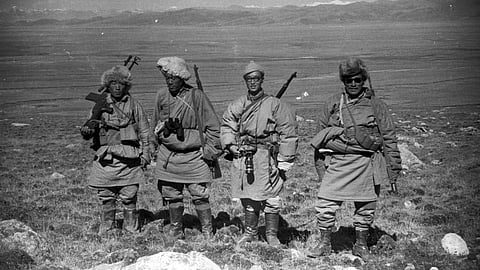
- HOMEGROWN WORLD
- #HGCREATORS
- #HGEXPLORE
- #HGVOICES
- #HGSHOP
- CAREERS
- ABOUT US
- CONTACT US

In the annals of history, there are chapters often obscured by the veils of secrecy and geopolitical intrigues. Such is the tale of the Tibetan Resistance — a story of a nation’s relentless struggle against occupation ever since the Communist Chinese invasion in 1950. While much of the world may be familiar with the Dalai Lama's exile and his non-violent advocacy for Tibetan autonomy, few are privy to the clandestine guerrilla warfare that unfolded between the mid-1950s and 1974, when thousands of Tibetans took up arms to resist the Chinese forces.
Mumbai, at the Experimenter Gallery in Colaba, is going to witness an exhibition titled Shadow Circus: A Personal Archive of Tibetan Resistance (1957 – 1974), which seeks to illuminate this hitherto forgotten chapter of Tibetan history. A partnership between renowned filmmakers Ritu Sarin and Tenzing Sonam and curator Natasha Ginwala, the exhibition promises to weave together an intricate tapestry of insight into the Tibetan Resistance, drawing from a cache of previously classified CIA documents, Lhamo Tsering's personal archives, and the filmmakers' evocative documentary, The Shadow Circus.
The CIA's involvement in the Tibetan Resistance commenced in 1956, during the height of the Cold War. Codenamed STCIRCUS, this covert operation stood as one of the CIA's most enduring endeavors until it was abruptly abandoned in the late 1960s when the United States sought to find common ground with China. Despite its extensive span, the covert nature of the operation relegated it to the shadowy corners of historical memory.
Lhamo Tsering, the father of the filmmaker Tenzing Sonam, was a key figure in the resistance and a liaison between the Tibetan fighters and the CIA. He foresaw the importance of preserving a record of their struggle against oppression. An archivist and mapmaker, Tsering documented daily life in the rugged terrain of Mustang; capturing everything from guerrilla training routines to communal exchanges and religious ceremonies. His invaluable collection of photographs, documents, letters, and maps became the foundation for an eight-volume history of the resistance, ensuring the continuity of this silenced narrative.
At the core of Shadow Circus lies an exploration of these arrested histories of the Tibetan resistance army. Tsering's personal archives and the audio-visual materials gathered by Sarin and Sonam converge to create a multidimensional mosaic of the resistance's tale. A centrepiece of the exhibition is a hand-drawn guerrilla training manual, a poignant relic preserved by Tsering himself, revealing the artistic expressions of the resistance fighters amidst their clandestine warfare.
Beyond the realm of geopolitics and calculated alliances, the exhibition delves into the human dimension of the Tibetan Resistance. It navigates the journey of individuals who risked their lives to gather intelligence and carry out guerrilla warfare in pursuit of an unrealized freedom struggle that resonates even today. Carole McGranahan, an anthropologist and historian, aptly describes this endeavor as an act to unshackle the histories of the Tibetan Resistance from their forced invisibility, infusing them with the acknowledgment and reverence they rightfully deserve.
In its quest for historical accuracy, the exhibition also challenges the established narratives that emphasize the essentially non-violent nature of the Tibetan freedom struggle from the 1970s onwards. By spotlighting the armed resistance, Shadow Circus serves as a catalyst for contemplation on the multifaceted aspects of the Tibetan struggle for autonomy, underscoring the complexities of resistance in the face of formidable forces.
"In my opinion, I don’t see our armed struggle as something that was helpful only at a certain point in our history, something that is finished. I believe we should look at it as one chapter in our continuing struggle for freedom, one that still has some meaning."
Lhamo Tsering, in an interview with The Indian Express, shortly before his death
Ritu Sarin and Tenzing Sonam, under the banner of White Crane Films, have long been champions of documenting the Tibetan experience. Presently, the are working out of Dharamshala, India. Their award-winning films and art installations focus on the questions of exile, identity, culture, and nationalism, and the preservation of their heritage. Their documentary film The Shadow Circus re-edited and incorporated into the exhibition, serves as a visual testimony to the untold stories of heroism and determination that defined the Tibetan Resistance.
As an accomplished curator and writer, Natasha Ginwala's expertise adds layers of artistic perspective to the exhibition. Her background in contemporary art, visual culture, and social justice enhances the exhibition's nuanced portrayal of the human aspect of resistance movements; transcending the boundaries of political power blocs.
The Shadow Circus: A Personal Archive of Tibetan Resistance (1957 – 1974) exhibition is a profound journey into a furtive realm of history that has long evaded public attention. As visitors step into the experiential world of Tibetan resistance fighters, they will be confronted with the resilience, bravery, and complexity of this chapter in history. More importantly, the exhibition serves as an ode to the enduring spirit of the Tibetan people, who, in their pursuit of freedom, continue to inspire generations with their unwavering determination and steadfast hope for a brighter tomorrow.
Shadow Circus: A Personal Archive of Tibetan Resistance (1957 – 1974)
Opening preview: July 27, 2023
On view till: August 26, 2023
Venue: Experimenter, Colaba
Find out more about the Experimenter Gallery here.
